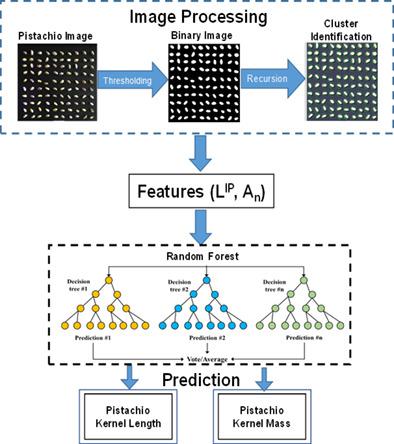当前位置:
X-MOL 学术
›
J. Food Process Eng.
›
论文详情
Our official English website, www.x-mol.net, welcomes your
feedback! (Note: you will need to create a separate account there.)
Prediction of size and mass of pistachio kernels using random Forest machine learning
Journal of Food Process Engineering ( IF 2.7 ) Pub Date : 2020-06-25 , DOI: 10.1111/jfpe.13473 Sriram K. Vidyarthi 1, 2 , Rakhee Tiwari 1 , Samrendra K. Singh 3 , Hong‐Wei Xiao 4
Journal of Food Process Engineering ( IF 2.7 ) Pub Date : 2020-06-25 , DOI: 10.1111/jfpe.13473 Sriram K. Vidyarthi 1, 2 , Rakhee Tiwari 1 , Samrendra K. Singh 3 , Hong‐Wei Xiao 4
Affiliation

|
The size and mass of the pistachio kernels are important parameters in pistachio industry worldwide, which are generally associated with pistachio classification and consumer's approval. In this study, we proposed a technique that accurately measures the size and mass of raw pistachio kernels simultaneously using image processing and machine‐learning ensemble. An image‐processing algorithm applying recursive method was used to detect a pistachio kernel from an image and estimate its size based on the pixels occupied. The number of pixels representing a pistachio kernel was used as its digital impression to estimate its size and mass. We employed Random Forest (RF) model to predict the mass of the individual pistachio kernels based on the patterns derived from the pistachio pixels in the image. The mean measured length (18.002 mm) of 100 pistachio kernels were close to the RF predicted length (18.608 mm). Similar close correlation for individual measured pistachio kernel mass and predicted mass was noticed having a bootstrapped residual of 0.036 ± 0.004 g with a class interval of 0.0358–0.0362 at 95% confidence level. Compared to the regression model, bootstrapping and uncertainty quantification showed a good prediction accuracy and robustness of the RF model.
中文翻译:

使用随机森林机器学习预测开心果仁的大小和质量
开心果仁的大小和质量是全世界开心果行业的重要参数,通常与开心果的分类和消费者的认可有关。在这项研究中,我们提出了一种使用图像处理和机器学习集成同时精确测量生开心果仁大小和质量的技术。使用递归方法的图像处理算法用于从图像中检测开心果仁,并根据占据的像素估算其大小。代表开心果内核的像素数量用作其数字印象来估计其大小和质量。我们基于图像中开心果像素衍生的图案,采用随机森林(RF)模型来预测单个开心果仁的质量。平均测量长度(18。002毫米)的100个开心果仁接近RF预测长度(18.608毫米)。观察到的单个开心果仁质量和预测质量具有相似的紧密相关性,在95%置信水平下,自举残差为0.036±0.004 g,分类间隔为0.0358-0.0362。与回归模型相比,自举和不确定性量化显示了RF模型的良好预测准确性和鲁棒性。
更新日期:2020-06-25
中文翻译:

使用随机森林机器学习预测开心果仁的大小和质量
开心果仁的大小和质量是全世界开心果行业的重要参数,通常与开心果的分类和消费者的认可有关。在这项研究中,我们提出了一种使用图像处理和机器学习集成同时精确测量生开心果仁大小和质量的技术。使用递归方法的图像处理算法用于从图像中检测开心果仁,并根据占据的像素估算其大小。代表开心果内核的像素数量用作其数字印象来估计其大小和质量。我们基于图像中开心果像素衍生的图案,采用随机森林(RF)模型来预测单个开心果仁的质量。平均测量长度(18。002毫米)的100个开心果仁接近RF预测长度(18.608毫米)。观察到的单个开心果仁质量和预测质量具有相似的紧密相关性,在95%置信水平下,自举残差为0.036±0.004 g,分类间隔为0.0358-0.0362。与回归模型相比,自举和不确定性量化显示了RF模型的良好预测准确性和鲁棒性。











































 京公网安备 11010802027423号
京公网安备 11010802027423号